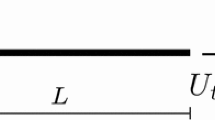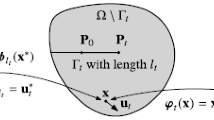Abstract
The present paper deals with a gradient damage modeling framework for the case of general shell structures. The particularity of this formulation is that, as for the balance of linear momentum, the damage evolution is also governed by a boundary value problem. In a first step, the generalized standard formalism of continuum thermodynamics is developed for the particular case of continuum damage mechanics. A model is presented that fulfils the requirements of irreversible processes. Then, in a second step, the model is adapted to shell kinematics in terms of the two-dimensional mid-surface. On the numerical side, we discuss the problem of numerically integrating this coupled problem and its implementation within the context of the finite element method. For the spatial discretization, a node-based approach is performed for the damage field that is related to a staggered global solution procedure. Here the popular four-nodes shell finite element is used for illustrative purposes. Finally, a set of simulations highlights the efficiency of the proposed framework.





Similar content being viewed by others
References
Abali, B.E., Klunker, A., Barchiesi, E., Placidi, L.: A novel phase-field approach to brittle damage mechanics of gradient metamaterials combining action formalism and history variables. ZAMM-Z. Angew. Math. Mech. 101(9), e202000289 (2021)
Ambati, M., Gerasimov, T., De Lorenzis, L.: Phase-field modeling of ductile fracture. Comput. Mech. 55(5), 1017–1040 (2015)
Ambrosio, L., Tortorelli, V.M.: Approximation of functionals depending on jumps by elliptic functionals via \(\Gamma \)-convergence. Commun. Pure Appl. Math. 43, 999–1036 (1990)
Awada, Z., Nedjar, B.: Finite viscoelastic modeling of yeast cells with an axisymmetrical shell approach. Mech. Res. Commun. 126, 104021 (2022)
Awada, Z., Nedjar, B.: On a finite strain modeling of growth in budding yeast. Int. J. Numer. Methods Biomed. Eng. (2023). https://doi.org/10.1002/cnm.3710
Borden, M.J., Hughes, T.J.R., Landis, C.M., Anvari, A., Lee, I.J.: A phase-field formulation for fracture in ductile materials: Finite deformation balance law derivation, plastic degradation, and stress triaxiality effects. Comput. Methods Appl. Mech. Eng. 321, 130–166 (2016)
Chapelle, D., Bathe, K.J.: The Finite Element Analysis of Shells—Fundamentals. Springer, Berlin, Heidelberg (2011)
Coleman, B., Gurtin, M.: Thermodynamics with internal variables. J. Chem. Phys. 47, 597–613 (1967)
Dvorkin, E.N., Bathe, K.J.: A continuum mechanics based four-node shell element for general nonlinear analysis. Eng. Comput. 1, 77–88 (1984)
Frémond, M., Nedjar, B.: Endommagement et principe des puissances virtuelles. Compt. Rend. l’Acad. Sci. Paris, Ser. II(317), 857–864 (1993)
Frémond, M., Nedjar, B.: Damage, gradient of damage and principle of virtual power. Int. J. Solids Struct. 33, 1083–1103 (1996)
Germain, P., Nguyen, Q.S., Suquet, P.: Continuum thermodynamics. ASME J. Appl. Mech. 50, 1010–1021 (1983)
Holzapfel, G.: Nonlinear Solid Mechanics. A Continuum Approach for Engineering. Wiley, Chichester (2000)
Lemaitre, J., Chaboche, J.L.: Mechanics of Solid Materials. Cambridge University Press, Cambridge (1990)
Miehe, C., Aldakheel, F., Raina, A.: Phase field modeling of ductile fracture at finite strains: a variational gradient-extended plasticity-damage theory. Int. J. Plast. 84, 1–32 (2016)
Miehe, C., Hofacker, M., Welschinger, F.: A phase field model for rate-independent crack propagation: robust algorithmic implementation based on operator splits. Comput. Methods Mech. Eng. 199, 2765–2778 (2010)
Miehe, C., Welschinger, F., Hofacker, M.: Thermodynamically consistent phase-field models of fracture: variational principles and multi-field fe implementations. Int. J. Numer. Methods Eng. 83, 1273–1311 (2010)
Nedjar, B.: Elastoplastic-damage modelling including the gradient of damage. Formulation and computational aspects. Int. J. Solids Struct. 38, 5421–5451 (2001)
Nedjar, B.: A theoretical and computational setting for geometrically nonlinear damage modelling framework. Comput. Mech. 30, 65–80 (2002)
Nedjar, B.: On a concept of directional damage gradient in transversely isotropic materials. Int. J. Solids Struct. 88–89, 56–67 (2016)
Nguyen, Q.S.: Some remarks on standard gradient models and gradient plasticity. Math. Mech. Solids 20(6), 760–769 (2015)
Oñate, E.: Structural analysis with the finite element method. In: Linear Statics. Volume 2. Beams, Plates and Shells. International Center for Numerical Methods in Engineering (CIMNE), Barcelona (2013)
Peerlings, R.H.J., de Borst, R., Brekelmans, W.A.M., de Vree, J.H.P.: Gradient-enhanced damage for quasi-brittle materials. Int. J. Numer. Methods Eng. 39, 3391–3403 (1986)
Placidi, L., Barchiesi, E., dell’Isola, F., Maksimov, V., Misra, A., Rezaei, N., Scrofani, A., Timofeev, D.: On a hemi-variational formulation for 2D elasto-plastic-damage strain gradient solid with granular microstructure. Math. Eng. 5(1), 1–24 (2022)
Simo, J.C., Fox, D.D., Rifai, M.S.: On a stress resultant geometrically exact shell model. Part II: the linear theory. Computational aspects. Comput. Methods Appl. Mech. Eng. 73, 53–92 (1989)
Simo, J.C., Ju, J.: Strain- and stress-based continuum damage models. Part I: formulation. Int. J. Solids Struct. 23(7), 821–840 (1987)
Simo, J.C., Ju, J.: Strain- and stress-based continuum damage models. Part II: computational aspects. Int. J. Solids Struct. 23(7), 841–869 (1987)
Spencer, A.: Constitutive theory for strongly anisotropic solids. In: A. Spencer (ed.) Continuum Theory of the Mechanics of Fibre-Reinforced Composites, CISM Courses and Lectures, vol. 282. Springer, Wien (1984)
Steinmann, P.: Formulation and computation of geometrically non-linear gradient damage. Int. J. Numer. Methods Eng. 46, 757–779 (1999)
Teichtmeister, S., Kienle, D., Aldakheel, F., Keip, M.A.: Phase-field modeling of fracture in anisotropic solids. Int. J. Non-Linear Mech. 97, 1–21 (2017)
Wick, T.: Modified Newton methods for solving fully monolithic phase-field quasi-static brittle fracture propagation. Comput. Methods Appl. Mech. Eng. 325, 577–611 (2017)
Wriggers, P.: Nonlinear Finite Element Methods. Springer, Berlin, Heidelberg (2008)
Wu, J.Y.: A unified phase-field theory for the mechanics of damage quasi-brittle failure. J. Mech. Phys. Solids 103, 72–99 (2017)
Zienkiewicz, O., Taylor, R.: The Finite Element Method, vol. 1, 5th edn. Butterworth-Heinemann, Oxford (2000)
Author information
Authors and Affiliations
Contributions
B. Nedjar wrote the main manuscript and Z. Awada prepared and performed the numerical simulations
Corresponding author
Ethics declarations
Conflicts of interest
The authors declare that they have no conflict of interest.
Additional information
Publisher's Note
Springer Nature remains neutral with regard to jurisdictional claims in published maps and institutional affiliations.
Rights and permissions
Springer Nature or its licensor (e.g. a society or other partner) holds exclusive rights to this article under a publishing agreement with the author(s) or other rightsholder(s); author self-archiving of the accepted manuscript version of this article is solely governed by the terms of such publishing agreement and applicable law.
About this article
Cite this article
Nedjar, B., Awada, Z. Standard gradient models and application to continuum damage in shell structures. Z. Angew. Math. Phys. 74, 163 (2023). https://doi.org/10.1007/s00033-023-02055-0
Received:
Revised:
Accepted:
Published:
DOI: https://doi.org/10.1007/s00033-023-02055-0
Keywords
- Continuum damage mechanics
- Generalized standard thermodynamics
- Damage gradient
- General shells
- Finite element method




